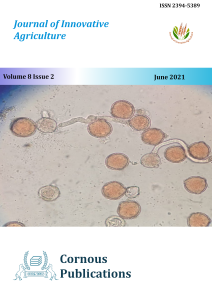
Journal of Innovative Agriculture
Peer Reviewed Open Access Journal
ISSN: 2394-5389 NAAS Rate: 4.05
Submit Manuscript
Peer Reviewed Open Access Journal
ISSN: 2394-5389 NAAS Rate: 4.05
Submit ManuscriptDeclining soil fertility is one of the major factor limiting crop productivity in Ethiopia. This experiment was therefore, conducted to evaluate grain yield response of maize to variable rates of compost and urea fertilizer integration. The experiment was arranged in factorial combination of three level of compost (0, 5 and 10 t ha-1) and three levels of mineral N fertilizer in the form of urea (0, 92 and 105 Kg ha-1). The experiment was laid out in randomized complete block design with three replications at the experimental field of Hawassa University, Southern Ethiopia. The result revealed significant difference among compost levels for all of the traits studied. There is significant difference among nitrogen levels for grain yield, number of kernel per row, number of kernel per ear and hundred grins weight. Significant difference among treatments (combination of compost level and nitrogen level) were observed for grain yield, number of rows per ear, number of kernel per row, number of kernel per ear and hundred kernel weights. The combination of compost and urea at the rate of 10 t ha-1 and 105 kg ha-1, respectively, produced the highest kernel yield (11.3 t ha-1) followed by (10 t ha-1 and 92 kg ha-1) and (5 t ha-1 and 105 kg ha-1) with compost and urea combination 9.4 and 8.3 t ha-1 grain yield respectively. Generally, the combination of 10 t ha-1 compost with urea at the rate of 105 kg ha-1 resulted with 63% yield advantage compared with the control plot. It is therefore; wise to recommend 10 t ha-1 compost combinations with 105 kg of urea for improved maize yield for the farmers in the research area and areas with similar agro-ecology and resources availability.
compost, fertilizer integrations, inorganic fertilizer, maize, organic fertilizer
Abera, G., & Wolde-Meskel, E. (2013). Soil properties, and soil organic carbon stocks of tropical andosol under different land uses.
Abera, T., Tanaand, T., & Pant, L. M. (2005). Grain yield and LER of maize-climbing bean intercropping as affected by inorganic, organic fertilisers and population density in western Oromiya, Ethiopia. Asian Journal of Plant Sciences.
Abunyewa, A. A., Osei, C., Asiedu, E. K., & Safo, E. Y. (2007). Integrated manure and fertilizer use, maize production and sustainable soil fertility in sub humid zone of West Africa. Journal of Agronomy.
Ahmed, S. (2006). Orientations: Toward a queer phenomenology. GLQ: A journal of Lesbian and Gay Studies, 12(4), 543-574.
Barbieri, P. A., Echeverría, H. E., Saínz Rozas, H. R., & Andrade, F. H. (2008). Nitrogen use efficiency in maize as affected by nitrogen availability and row spacing. Agronomy Journal, 100(4), 1094-1100.
Black, J. W., Duncan, W. A., & Shanks, R. G. (1965). Comparison of some properties of pronethalol and propranolol. British Journal of Pharmacology and Chemotherapy, 25(3), 577.
CSA (Central Statistical Agency) 2016. Crop Production Forecast Sample Survey, 2014/10. Report on Area and Production for Major Crops (for Private Peasant Holdings ‘Meher’ season). Addis Ababa, Ethiopia.
CSA. 2018. Agricultural Sample survey: Report on area and production of major crops (private peasant holdings, Meher season). Statistical Bulletin, (1).Addis Abeba.
EARO/CIMMYT.2002. Ethiopian Agricultural Research Organization (EARO), Research strategy plan for maize. Addis Ababa, Ethiopia.
FAO (Food and Agriculture organization of the United Nations). 2016. Crop Prospects and Food Situation
Jackson, M. L. (1958). Soil chemical analysis prentice Hall. Inc., Englewood Cliffs, NJ, 498, 183-204.
Khan, J.A. (2008) Research Methodology. A.P.H. Publishing Corporation, New Delhi.
Laekemariam, F., & Gidago, G. (2012). Response of maize (Zea mays L.) to integrated fertilizer application in Wolaita, South Ethiopia. Advances in Life Science and Technology, 5, 21-30.
MAFF (Ministry of Agriculture, Fisheries and Food) (1986) Manual of Veterinary Parasitological Laboratory Techniques, ADAS, HMSO, UK.
Martin, E. (1991). The egg and the sperm: How science has constructed a romance based on stereotypical male-female roles. Signs: journal of women in culture and society, 16(3), 485-501.
Rajeshwari, R. S., Hebsur, N. S., Pradeep, H. M., & Bharamagoudar, T. D. (2007). Effect of integrated nitrogen management on growth and yield of maize.
Shah, S. T. H., Zamir, M. S. I., Waseem, M., Ali, A., Tahir, M., & Khalid, W. B. (2009). Growth and yield response of maize (Zea mays L.) to organic and inorganic sources of nitrogen. Pak J Life Soc Sci, 7(2), 108-111.
Shah, Z., & Ahmad, M. I. (2006). Effect of integrated use of farm yard manure and urea on yield and nitrogen uptake of wheat. Journal of agricultural and biological science, 1(1), 60-65.
Thomas, G. W. (1982). Exchangeable cations. Methods of soil analysis: Part 2 chemical and microbiological properties, 9, 159-165.
Warren, H. L., Huber, D. M., Nelson, D. W., & Mann, O. W. (1975). Stalk Rot Incidence and Yield of Corn as Affected by Inhibiting Nitrification of Fall‐applied Ammonium 1. Agronomy Journal, 67(5), 655-660.
Watanabe, F. S., & Olsen, S. R. (1965). Test of an ascorbic acid method for determining phosphorus in water and NaHCO3 extracts from soil. Soil Science Society of America Journal, 29(6), 677-678.
